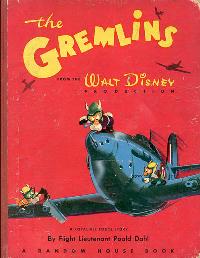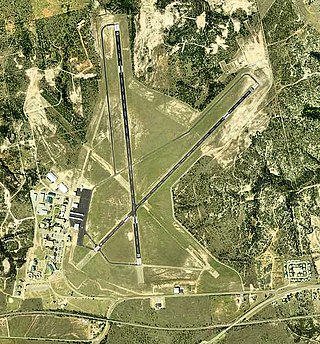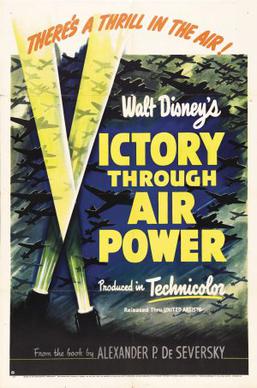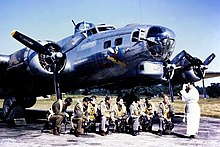
Roald Dahl was a British author of popular children's literature and short stories, a poet, screenwriter and a wartime fighter ace. His books have sold more than 300 million copies worldwide. He has been called "one of the greatest storytellers for children of the 20th century".

A gremlin is a mischievous fictional creature invented at the beginning of the 20th century to originally explain malfunctions in aircraft, and later in other machinery, processes, and their operators. Depictions of these creatures vary widely. Stories about them and references to them as the causes of especially inexplicable technical and mental problems of pilots were especially popular during and after World War II.

The Handley Page HP.52 Hampden is a British twin-engine medium bomber that was operated by the Royal Air Force (RAF). It was part of the trio of large twin-engine bombers procured for the RAF, joining the Armstrong Whitworth Whitley and Vickers Wellington. The Hampden was powered by Bristol Pegasus radial engines but a variant known as the Handley Page Hereford had in-line Napier Daggers.

Roald Dahl short stories bibliography is a comprehensive annotated list of short stories written by Roald Dahl.

Falling Hare is a 1943 Warner Bros. Merrie Melodies cartoon directed by Bob Clampett. The cartoon features Bugs Bunny.

The Women Airforce Service Pilots (WASP) was a civilian women pilots' organization, whose members were United States federal civil service employees. Members of WASP became trained pilots who tested aircraft, ferried aircraft and trained other pilots. Their purpose was to free male pilots for combat roles during World War II. Despite various members of the armed forces being involved in the creation of the program, the WASP and its members had no military standing.

The Gremlins is a children's novel written by British author Roald Dahl and published in 1943. In writing the book, Dahl draws on his own experience as a Royal Air Force (RAF) pilot during the Second World War. The story's principal character Gus, an RAF pilot, has his Hawker Hurricane destroyed over the English Channel by a gremlin—mischievous creatures who were part of RAF folklore. As they parachute into the water, Gus convinces the gremlins to join forces against a common enemy: Hitler and the Nazis. It was Dahl's first book and was written for Walt Disney Productions, in anticipation of a feature-length animated film that was never made.

Going Solo is a book by Roald Dahl, first published by Jonathan Cape in London in 1986. It is a continuation of his autobiography describing his childhood, Boy and detailed his travel to Africa and exploits as a World War II pilot.

The 91st Bombardment Group (Heavy) was an air combat unit of the United States Army Air Forces during the Second World War. Classified as a heavy bombardment group, the 91st operated Boeing B-17 Flying Fortress aircraft and was known unofficially as "The Ragged Irregulars" or as "Wray's Ragged Irregulars", after the commander who took the group to England. During its service in World War II the unit consisted of the 322nd, 323rd, 324th, and 401st Bomb Squadrons. The 91st Bombardment Group is most noted as the unit in which the bomber Memphis Belle flew, and for having suffered the greatest number of losses of any heavy bombardment group in World War II.

Russian Rhapsody is a 1944 Warner Bros. Merrie Melodies cartoon directed by Bob Clampett. The short was released on May 20, 1944.

Royal Air Force Kimbolton or more simply RAF Kimbolton is a former Royal Air Force station located 8 miles (13 km) west of Huntingdon, Cambridgeshire, England.

Some Time Never: A Fable for Supermen is a 1948 book by Roald Dahl, his first adult novel. Dahl began writing it after editor Maxwell Perkins expressed an interest in publishing a novel length book if Dahl were to write it. The book was met with predominantly poor reception and was considered to be a failure, although it is historically noteworthy as one of the first novels about nuclear war to be published after the atomic bombings of Hiroshima and Nagasaki. The story is a darker take on the same premise as Dahl's first book for children, The Gremlins.
Fifinella (1913–1931) was a British Thoroughbred racehorse and broodmare. In a career that lasted from 1915 until 1917 she ran seven times and won four races. She was the highest-rated British two-year-old of either sex in 1915 and went on to greater success the following season. As a three-year-old in 1916 she won the Derby and Oaks both of which were run that year at Newmarket. She was the sixth and most recent filly to win the Derby.

No. 322 (Dutch) Squadron of the Royal Air Force was a fighter squadron during the Second World War.

Avenger Field is a Texas airport in Nolan County, three miles west of Sweetwater. The National Plan of Integrated Airport Systems for 2011–2015 called it a general aviation facility.
Jennet Conant is an American non-fiction author and journalist. She has written five books about World War II, three of which have appeared on the New York Times Best Seller list: Tuxedo Park: A Wall Street Tycoon and the Secret Palace of Science that Changed the Course of WWII, 109 East Palace: Robert Oppenheimer and the Secret City of Los Alamos, The Irregulars: Roald Dahl and the British Spy Ring in Wartime Washington, and A Covert Affair: Julia Child and Paul Child in the OSS.

Victory Through Air Power is an American animated documentary propaganda film produced by Walt Disney Productions and released by United Artists on July 17, 1943. It is based on the 1942 book Victory Through Air Power by Alexander P. de Seversky. De Seversky appeared in the film, an unusual departure from the Disney animated feature films of the time.
The Battle of Athens on 20 April 1941 is the name given by author Roald Dahl to a dog-fighting air battle over Athens fought for half an hour between the Royal Air Force and the Luftwaffe towards the end of the Battle of Greece.

Roald Dahl (1916–1990) was a British author and scriptwriter, and "the most popular writer of children's books since Enid Blyton", according to Philip Howard, the literary editor of The Times. He was raised by his Norwegian mother, who took him on annual trips to Norway, where she told him the stories of trolls and witches present in the dark Scandinavian fables. Dahl was influenced by the stories and returned to many of the themes in his children's books. His mother also nurtured a passion in the young Dahl for reading and literature.

Elizabeth Maxine Chambers was one of the first female pilots in the Women Airforce Service Pilots (WASP) program in which women took on non-combat flying duties so more male pilots were available for combat. She was in WASP Class of 44-W-3 as part of the 318th Army Air Forces Flying Training Detachment. She became a pilot shortly after her husband lost his life while flying, despite the fact that she had a new baby, and was the only recent widow and mother to have served as a WASP.


















